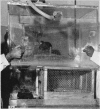Abstract
A Plexiglas isolator for rearing germfree vertebrates is described. Plastic components were precut and finished by a Plexiglas supplier. This equipment is relatively inexpensive; moreover, neither special facilities nor skills are required in their construction. Advantages of this type of isolator are: readily dismantled for cleaning, durable, excellent visibility of the interior, and minimal maintenance. In 30 separate groups of animals, 27 of these yielded germfree chicks. Many of these chicks were reared germfree for 4 weeks; and several were maintained for about 2 months, without microbial contamination. Pure cultures of Candida albicans, Streptococcus faecalis, and Clostridium perfringens were established as monocontaminations in the intestinal tracts of chickens. In contrast, Alcaligenes faecalis ATCC 9220 failed to grow in the gut of chicks, following peroral administration of this organism. All chicks described were employed on other experiments, and were killed for various assays at times specified.
Full text
PDF






Images in this article
Selected References
These references are in PubMed. This may not be the complete list of references from this article.
- FORBES M., PARK J. T. Growth of germ-free and conventional chicks: effect of diet, dietary penicillin and bacterial environment. J Nutr. 1959 Jan 10;67(1):69–84. doi: 10.1093/jn/67.1.69. [DOI] [PubMed] [Google Scholar]
- FORBES M., PARK J. T., LEV M. Role of the intestinal flora in the growth response of chicks to dietary penicillin. Ann N Y Acad Sci. 1959 May 8;78:321–327. doi: 10.1111/j.1749-6632.1959.tb53117.x. [DOI] [PubMed] [Google Scholar]
- GORDON H. A. The germ-free animal. Its use in the study of "physiologic" effects of the normal microbial flora on the animal host. Am J Dig Dis. 1960 Oct;5:841–867. doi: 10.1007/BF02232187. [DOI] [PubMed] [Google Scholar]
- GORDON H. A., WAGNER M., LUCKEY T. D., REYNIERS J. A. An encephalomeningeal syndrome selectively affecting newly hatched germfree and monocontaminated chickens. J Infect Dis. 1959 Jul-Aug;105(1):31–37. doi: 10.1093/infdis/105.1.31. [DOI] [PubMed] [Google Scholar]
- LEVENSON S. M., MASON R. P., HUBER T. E., MALM O. J., HOROWITZ R. E., EINHEBER A. Germfree animals in surgical research. Ann Surg. 1959 Oct;150:713–730. doi: 10.1097/00000658-195910000-00014. [DOI] [PMC free article] [PubMed] [Google Scholar]
- PHILLIPS A. W., SMITH J. E. Germfree animal techniques and their applications. Adv Appl Microbiol. 1959;1:141–174. doi: 10.1016/s0065-2164(08)70478-7. [DOI] [PubMed] [Google Scholar]
- TREXLER P. C., REYNOLDS L. I. Flexible film apparatus for the rearing and use of germfree animals. Appl Microbiol. 1957 Nov;5(6):406–412. doi: 10.1128/am.5.6.406-412.1957. [DOI] [PMC free article] [PubMed] [Google Scholar]
- TREXLER P. C. The use of plastics in the design of isolator systems. Ann N Y Acad Sci. 1959 May 8;78:29–36. doi: 10.1111/j.1749-6632.1959.tb53093.x. [DOI] [PubMed] [Google Scholar]






